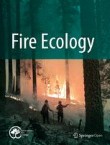Fire Ecology is the official journal of the Association for Fire Ecology.
Fuel treatment effectiveness at the landscape scale: a systematic review of simulation studies comparing treatment scenarios in North America
The risk of destructive wildfire on fire-prone landscapes with excessive fuel buildup has prompted the use of fuel reduction treatments to protect valued resources from wildfire damage. The question of how to ...
